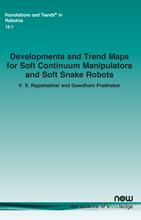Developments and Trend Maps for Soft Continuum Manipulators and Soft Snake Robots
By V. S. Rajashekhar, Indian Institute of Technology Kanpur, India, raja23@iitk.ac.in | Gowdham Prabhakar, Indian Institute of Technology Kanpur, India, gowdhampg@iitk.ac.in
Abstract
Soft robots are more human-friendly than rigid-bodied robots. This is due to their soft nature that does not harm humans while interacting. This work provides the developments and trend maps for soft continuum manipulators (SCM) and soft snake robots (SSR). Although they are functionally different, they are structurally similar in appearance. The way the robot is modelled, the materials it is made up of, and the various manufacturing methods for the soft continuum robots (SCR) are presented. Most importantly, the soft sensors and soft actuators used for these SCRs are discussed. Then, the manipulation and locomotion of these SCRs are presented. The trend map for the SCM and SSR are laid out and described in detail. We feel that this work will introduce the readers to the soft continuum world and give an overview of the future of SCM and SSR.
Developments and Trend Maps for Soft Continuum Manipulators and Soft Snake Robots
Soft robots are more human-friendly than rigid-bodied robots. This is because they are light in weight, compliant in nature, safer during human interaction, and efficient in locomotion. They have good impact resistance and can access confined spaces due to their soft nature.
This monograph focuses on soft robots, and in particular, provides an overview of developments and trend maps for soft continuum manipulators (SCM) and soft snake robots (SSR). Although they are functionally different, they are structurally similar in appearance. The way the robot is modelled, the materials it is made up of, and the various manufacturing methods for the soft continuum robots (SCR) are presented.
Soft sensors and soft actuators used for these SCRs are discussed, and thereafter the manipulation and locomotion of these SCRs are presented. The trend map for the SCM and SSR are laid out and described in detail.
The work provides readers with an introduction to the soft continuum world and gives an overview of the future of SCM and SSR.
